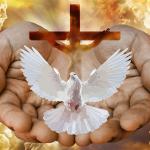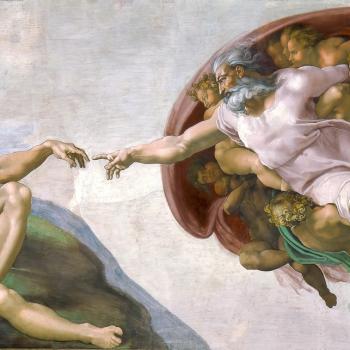The Holy Trinity
A. Let us play.
As a child, I learned from the Baltimore Catechism that God has only one nature – a divine one – but has three distinct persons – Father, Son and Holy Spirit. St. Patrick allegedly used a shamrock to explain this to the Celts of Ireland in 432 CE. But now, at age 74, the child in me wants to have mathematical fun with this great mystery. Here goes: God has one nature and three persons, but one of these three persons – the Son – incarnated and became a man, thus adopting a second nature – a human one. My question is, after his Ascension, didn’t Jesus sneak a second nature into the Godhead since he was divine and human at the same time? Or did he have to surrender his human passport at the pearly gates?
B. Let’s Get Serious
The early councils of the church wrestled with this notion of three persons in the one God. And what was the issue? The Councils of Nicaea in 325 CE and Constantinople in 381 CE, claimed that both the Son and the Spirit ‘proceeded’ directly and solely from the Father. But later councils said that the Spirit proceeded from the Father and from the Son. In other words, where Jesus proceeded directly and solely from the Father, the Spirit proceeded from both the Father and from the Son. Those last four words, ‘and from the Son’ in the English version of the Creed are a translation of the single Latin word, ‘filioque.’ Theologians who had debated how many angels could dance on the head of a pin, now abandoned the dancefloor, and redeployed their mental weapons in trying to score hits in the ‘filioque’ war. Various camps took up the cudgels for the three injured parties. For some, the term ‘filioque’ implied a serious underestimation of the Father’s role in the Trinity (the Son was stealing part of the Father’s thunder); for others, denying ‘filioque’ implied a serious underestimation of the role of the Son (making him inferior to the Father within the Trinity). And for some, the poor Holy Spirit was being made the runt of the litter or simply a dove – if you don’t mind me mixing my metaphors.
By 1014 CE, this phrase – ‘filioque’ – had been incorporated into the Western liturgy. In 1054 CE, this led to a schism between the Eastern (Greek Orthodox) and Western (Roman Catholic) versions of Christianity. In time, it became a very bloody affair and is still a source of dogmatic disagreement between them.
C. An Analogy
I’m gonna develop an analogy that draws upon nature, philosophy, mysticism and quantum mechanics! The great Roman citizen and Egyptian philosopher, Plotinus (died 270 CE), whom some regard as second only to Plato, in the hierarchy of philosophers, distinguished between ‘creatio ex nihilo’ (creation out of nothing) and ‘emanatio ab Deo’ (emanation from God). He believed that the universe and all its denizens arrived through the latter mechanism. I’m in full agreement with him. I don’t believe that God goes into his workshop when His alarm clock goes off in the morning and wonders, “What will I create today?” and then proceeds to pull previously non-existent parrots and rabbits, oak trees and hippos, dolphins and mosquitoes out of His hat. Rather, I believe, that the phenomenological world (all that can be experienced) is a manifestation of His Very Being.
There’s a wonderful story of St. Francis encountering a ‘dead’ snow-clad apple tree in mid-Winter and pleading, “Speak to me of God!” Whereupon the tree burst into bloom, shaking off the snow and clothing itself with a costume of pink blossoms. What happened? Was there a sudden shift in the biochemistry of the tree? Or was it that Francis, the mystic, entered an altered state of consciousness which transported him out of space-time, allowing him to see all of the seasons, or any season of his choice (Winter, Spring, Summer or Autumn) in the barren, icicled apple tree?
But it gets even more curious. According to quantum mechanics, all possibilities are present ‘in potentia’ until an observer collapses the wave to a specific outcome. Thus, all phases or possibilities are inherent, but their manifestation depends on the consciousness of the observer in order to become actual experiences.
So now to the analogy. Daffodils are my favorite flowers; I love the tall, straight, elegant, poised stalk with its orthogonally directed yellow, fringed cup. The bulb is kinda ugly; I’m glad it stays underground. So, here’s the deal. I don’t think that the bulb creates the stalk, rather the stalk is a manifestation of the bulb. Similarly, the flower is a manifestation of the bulb. Now, here’s the question: Is the flower merely a manifestation of the bulb or is it a manifestation of the bulb and of the stalk? If the latter is true, then count me in on the ‘filioque’ side of the debate. So, the Father might be the bulb, the Son the stalk and the flower the Spirit.
To compound matters, we humans are simplistically imposing chronology on a timeless phenomenon. We are overlaying the daffodil with an artificial time-template. To the human, the bulb comes before the stalk which comes before the flower, but in actuality they are all concurrently present.
Maybe when Jesus said, ‘look at the lilies of the field’ he was saying the same thing as I just said but, obviously, his favorite flower was the lily!

















